Analysis of Decision-Making Biases in the Real World: Report
VerifiedAdded on 2021/06/17
|16
|3897
|46
Report
AI Summary
This report analyzes decision-making biases, focusing on Herbert Simon's concepts of bounded rationality, heuristics, bounded awareness, and framing effects. The report is divided into two parts: an essay exploring Simon's theories and a case study examining Volkswagen's emissions scandal. The essay delves into the three key biases, explaining how they influence decision-making processes. The case study illustrates these biases in a real-world business context, discussing the scenario, bias recognition, methods to measure biases, and strategies to overcome them. The report concludes with a summary of findings and suggestions for further research, highlighting the practical implications of understanding these biases for effective leadership and management.
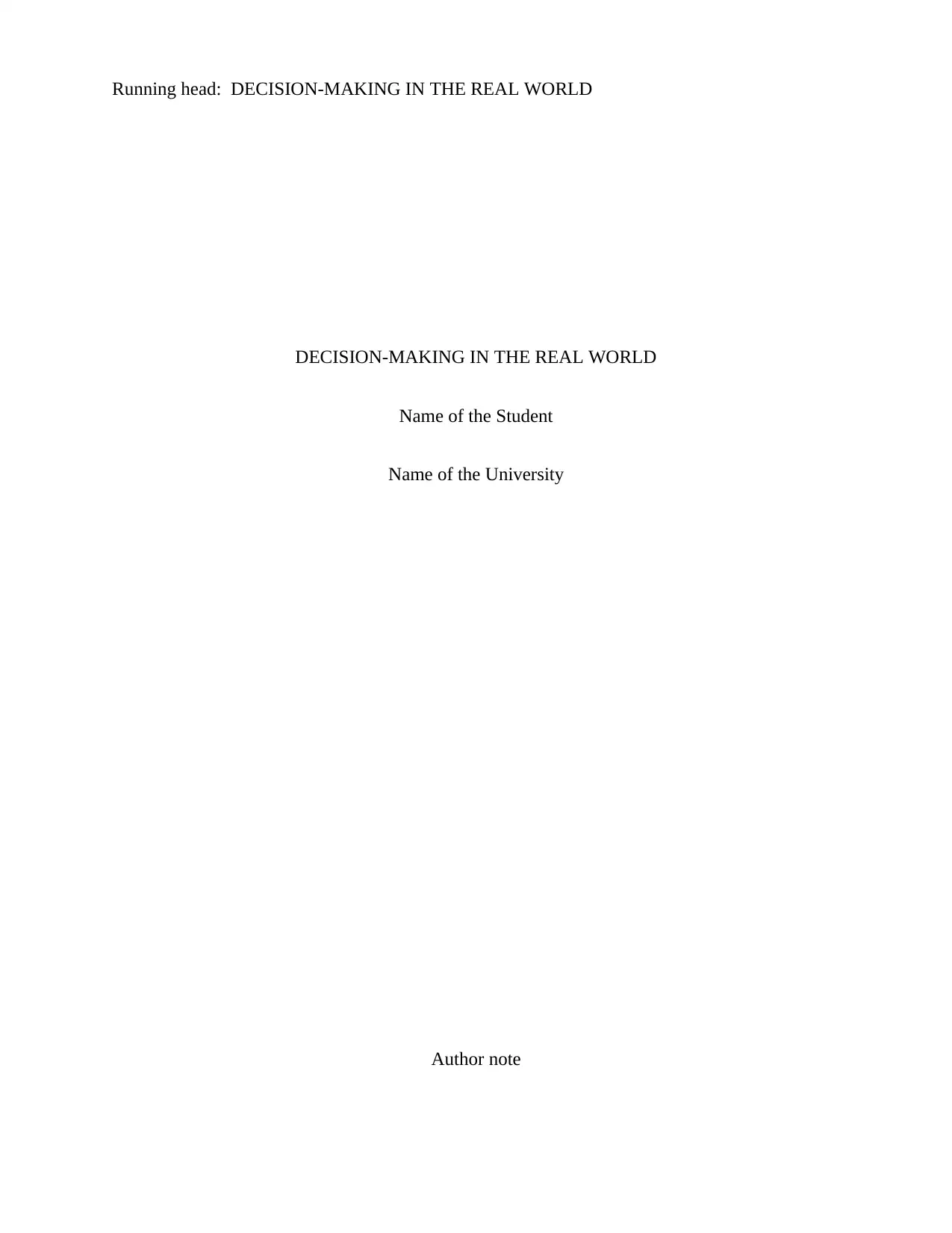
Running head: DECISION-MAKING IN THE REAL WORLD
DECISION-MAKING IN THE REAL WORLD
Name of the Student
Name of the University
Author note
DECISION-MAKING IN THE REAL WORLD
Name of the Student
Name of the University
Author note
Paraphrase This Document
Need a fresh take? Get an instant paraphrase of this document with our AI Paraphraser
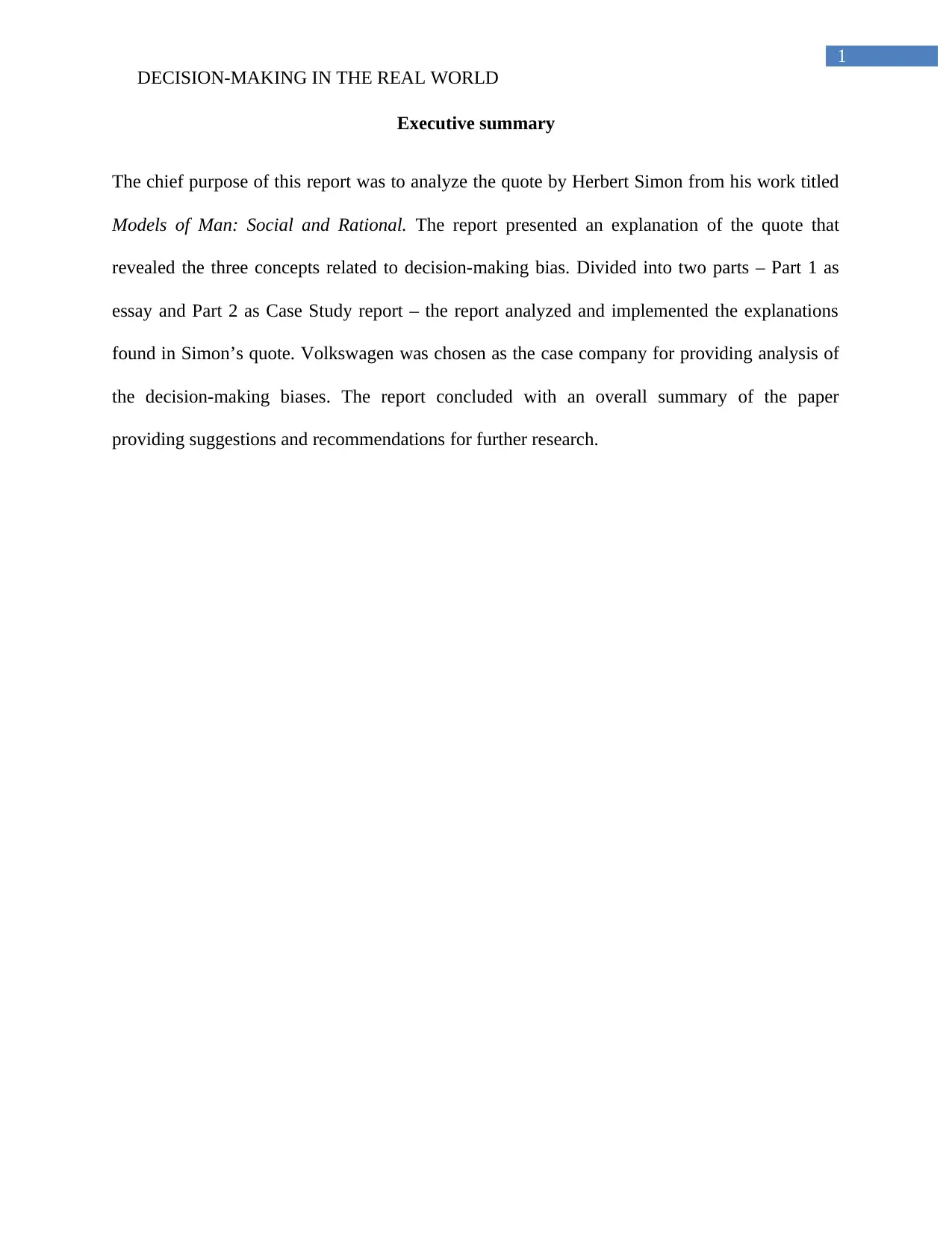
1
DECISION-MAKING IN THE REAL WORLD
Executive summary
The chief purpose of this report was to analyze the quote by Herbert Simon from his work titled
Models of Man: Social and Rational. The report presented an explanation of the quote that
revealed the three concepts related to decision-making bias. Divided into two parts – Part 1 as
essay and Part 2 as Case Study report – the report analyzed and implemented the explanations
found in Simon’s quote. Volkswagen was chosen as the case company for providing analysis of
the decision-making biases. The report concluded with an overall summary of the paper
providing suggestions and recommendations for further research.
DECISION-MAKING IN THE REAL WORLD
Executive summary
The chief purpose of this report was to analyze the quote by Herbert Simon from his work titled
Models of Man: Social and Rational. The report presented an explanation of the quote that
revealed the three concepts related to decision-making bias. Divided into two parts – Part 1 as
essay and Part 2 as Case Study report – the report analyzed and implemented the explanations
found in Simon’s quote. Volkswagen was chosen as the case company for providing analysis of
the decision-making biases. The report concluded with an overall summary of the paper
providing suggestions and recommendations for further research.
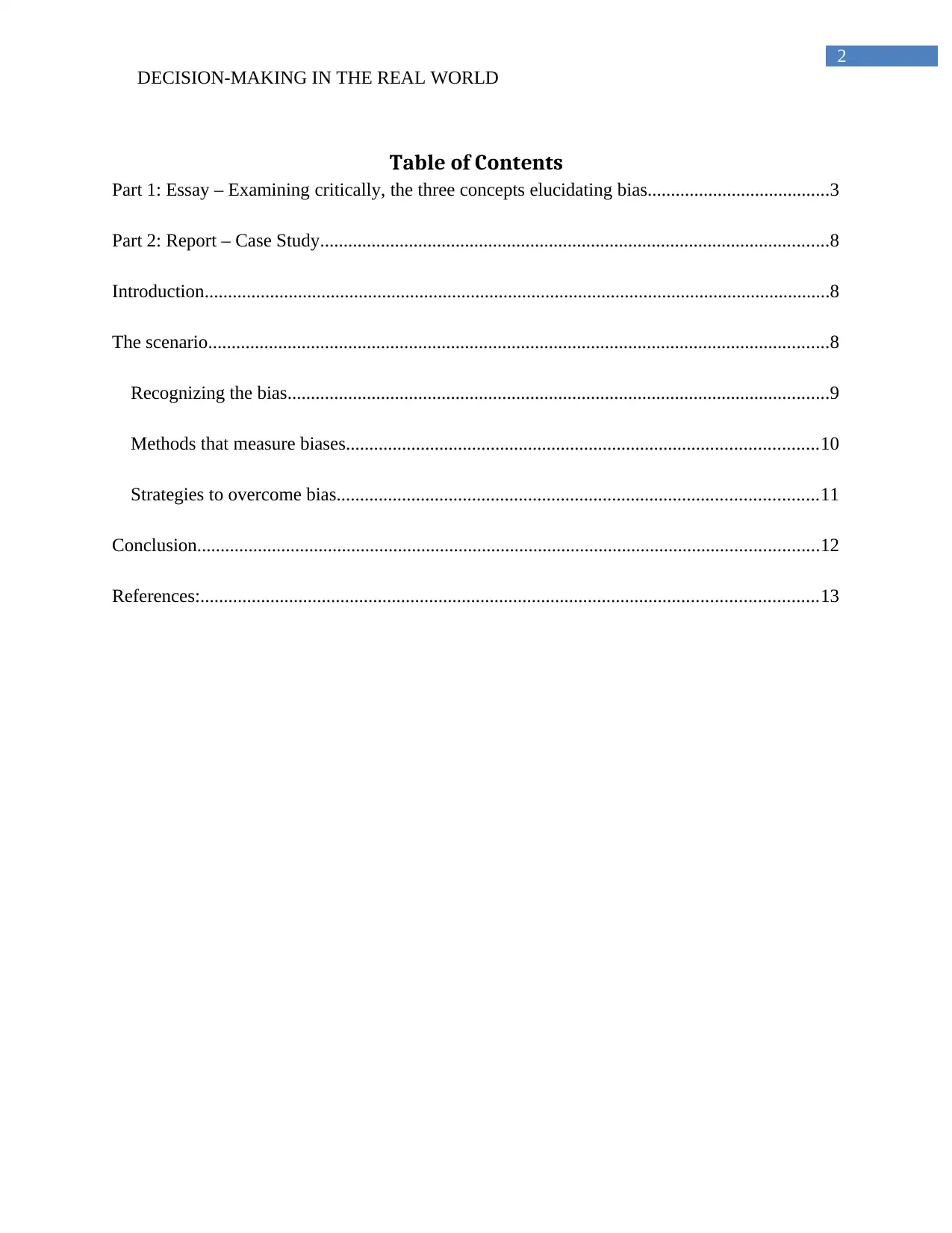
2
DECISION-MAKING IN THE REAL WORLD
Table of Contents
Part 1: Essay – Examining critically, the three concepts elucidating bias.......................................3
Part 2: Report – Case Study.............................................................................................................8
Introduction......................................................................................................................................8
The scenario.....................................................................................................................................8
Recognizing the bias....................................................................................................................9
Methods that measure biases.....................................................................................................10
Strategies to overcome bias.......................................................................................................11
Conclusion.....................................................................................................................................12
References:....................................................................................................................................13
DECISION-MAKING IN THE REAL WORLD
Table of Contents
Part 1: Essay – Examining critically, the three concepts elucidating bias.......................................3
Part 2: Report – Case Study.............................................................................................................8
Introduction......................................................................................................................................8
The scenario.....................................................................................................................................8
Recognizing the bias....................................................................................................................9
Methods that measure biases.....................................................................................................10
Strategies to overcome bias.......................................................................................................11
Conclusion.....................................................................................................................................12
References:....................................................................................................................................13
⊘ This is a preview!⊘
Do you want full access?
Subscribe today to unlock all pages.

Trusted by 1+ million students worldwide
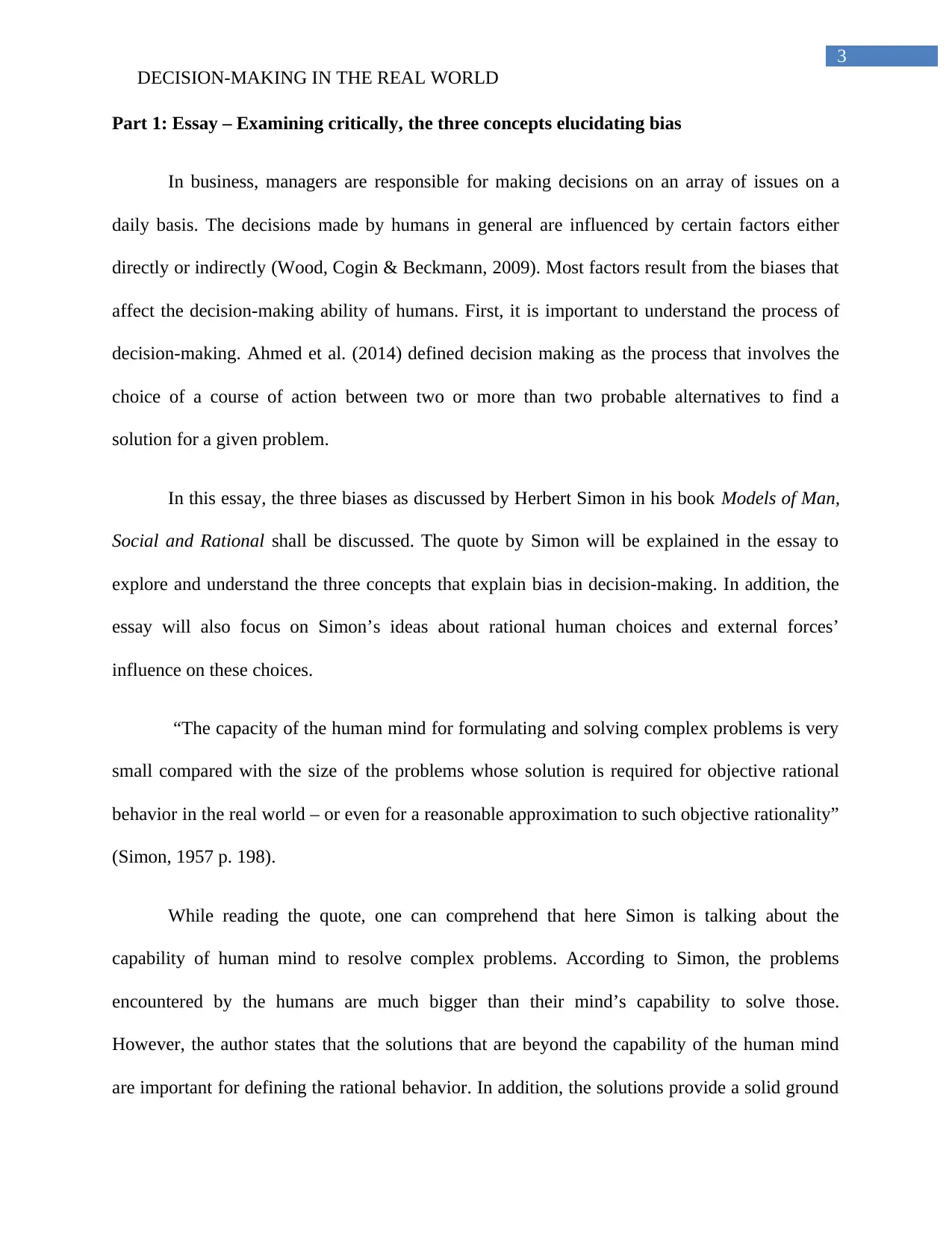
3
DECISION-MAKING IN THE REAL WORLD
Part 1: Essay – Examining critically, the three concepts elucidating bias
In business, managers are responsible for making decisions on an array of issues on a
daily basis. The decisions made by humans in general are influenced by certain factors either
directly or indirectly (Wood, Cogin & Beckmann, 2009). Most factors result from the biases that
affect the decision-making ability of humans. First, it is important to understand the process of
decision-making. Ahmed et al. (2014) defined decision making as the process that involves the
choice of a course of action between two or more than two probable alternatives to find a
solution for a given problem.
In this essay, the three biases as discussed by Herbert Simon in his book Models of Man,
Social and Rational shall be discussed. The quote by Simon will be explained in the essay to
explore and understand the three concepts that explain bias in decision-making. In addition, the
essay will also focus on Simon’s ideas about rational human choices and external forces’
influence on these choices.
“The capacity of the human mind for formulating and solving complex problems is very
small compared with the size of the problems whose solution is required for objective rational
behavior in the real world – or even for a reasonable approximation to such objective rationality”
(Simon, 1957 p. 198).
While reading the quote, one can comprehend that here Simon is talking about the
capability of human mind to resolve complex problems. According to Simon, the problems
encountered by the humans are much bigger than their mind’s capability to solve those.
However, the author states that the solutions that are beyond the capability of the human mind
are important for defining the rational behavior. In addition, the solutions provide a solid ground
DECISION-MAKING IN THE REAL WORLD
Part 1: Essay – Examining critically, the three concepts elucidating bias
In business, managers are responsible for making decisions on an array of issues on a
daily basis. The decisions made by humans in general are influenced by certain factors either
directly or indirectly (Wood, Cogin & Beckmann, 2009). Most factors result from the biases that
affect the decision-making ability of humans. First, it is important to understand the process of
decision-making. Ahmed et al. (2014) defined decision making as the process that involves the
choice of a course of action between two or more than two probable alternatives to find a
solution for a given problem.
In this essay, the three biases as discussed by Herbert Simon in his book Models of Man,
Social and Rational shall be discussed. The quote by Simon will be explained in the essay to
explore and understand the three concepts that explain bias in decision-making. In addition, the
essay will also focus on Simon’s ideas about rational human choices and external forces’
influence on these choices.
“The capacity of the human mind for formulating and solving complex problems is very
small compared with the size of the problems whose solution is required for objective rational
behavior in the real world – or even for a reasonable approximation to such objective rationality”
(Simon, 1957 p. 198).
While reading the quote, one can comprehend that here Simon is talking about the
capability of human mind to resolve complex problems. According to Simon, the problems
encountered by the humans are much bigger than their mind’s capability to solve those.
However, the author states that the solutions that are beyond the capability of the human mind
are important for defining the rational behavior. In addition, the solutions provide a solid ground
Paraphrase This Document
Need a fresh take? Get an instant paraphrase of this document with our AI Paraphraser
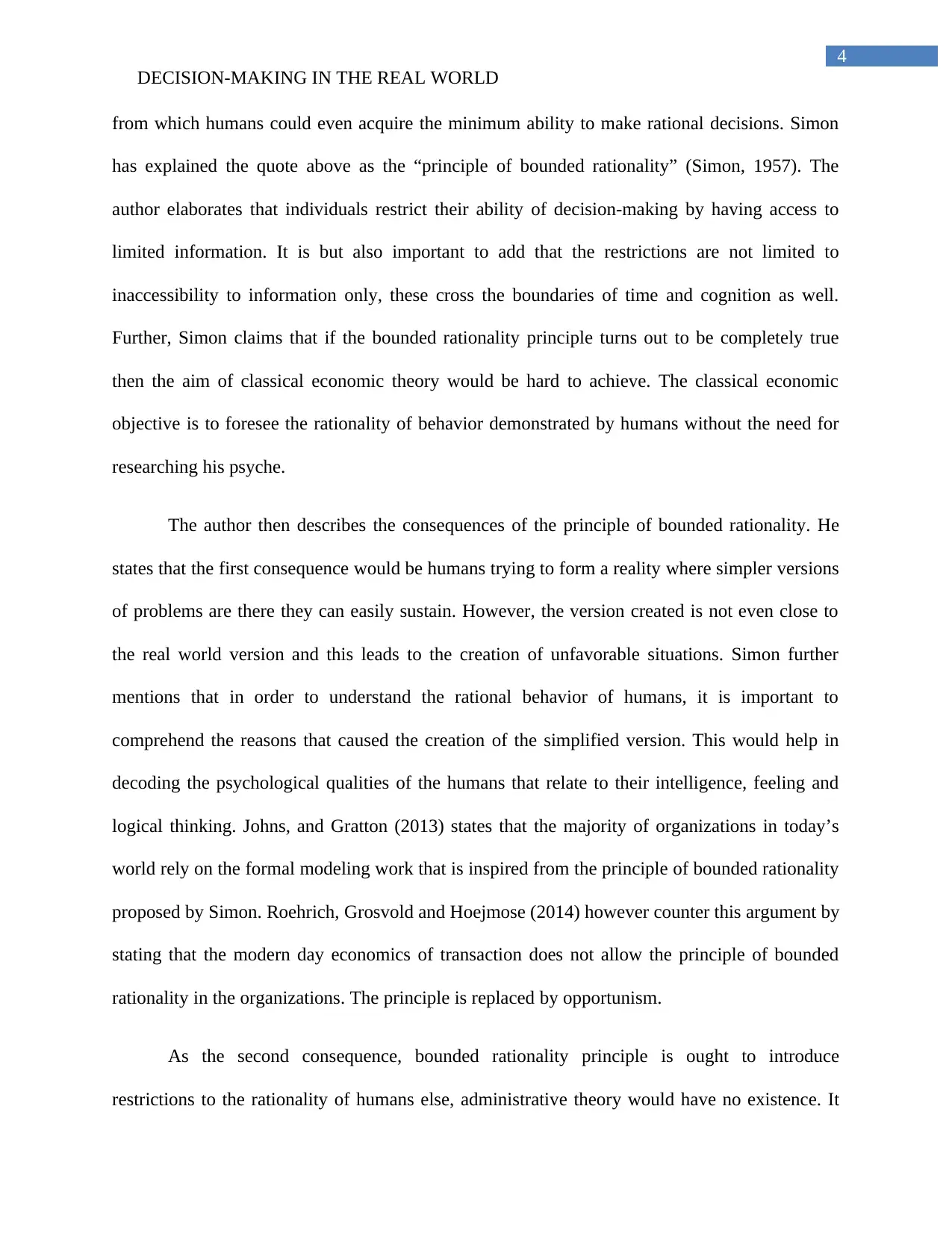
4
DECISION-MAKING IN THE REAL WORLD
from which humans could even acquire the minimum ability to make rational decisions. Simon
has explained the quote above as the “principle of bounded rationality” (Simon, 1957). The
author elaborates that individuals restrict their ability of decision-making by having access to
limited information. It is but also important to add that the restrictions are not limited to
inaccessibility to information only, these cross the boundaries of time and cognition as well.
Further, Simon claims that if the bounded rationality principle turns out to be completely true
then the aim of classical economic theory would be hard to achieve. The classical economic
objective is to foresee the rationality of behavior demonstrated by humans without the need for
researching his psyche.
The author then describes the consequences of the principle of bounded rationality. He
states that the first consequence would be humans trying to form a reality where simpler versions
of problems are there they can easily sustain. However, the version created is not even close to
the real world version and this leads to the creation of unfavorable situations. Simon further
mentions that in order to understand the rational behavior of humans, it is important to
comprehend the reasons that caused the creation of the simplified version. This would help in
decoding the psychological qualities of the humans that relate to their intelligence, feeling and
logical thinking. Johns, and Gratton (2013) states that the majority of organizations in today’s
world rely on the formal modeling work that is inspired from the principle of bounded rationality
proposed by Simon. Roehrich, Grosvold and Hoejmose (2014) however counter this argument by
stating that the modern day economics of transaction does not allow the principle of bounded
rationality in the organizations. The principle is replaced by opportunism.
As the second consequence, bounded rationality principle is ought to introduce
restrictions to the rationality of humans else, administrative theory would have no existence. It
DECISION-MAKING IN THE REAL WORLD
from which humans could even acquire the minimum ability to make rational decisions. Simon
has explained the quote above as the “principle of bounded rationality” (Simon, 1957). The
author elaborates that individuals restrict their ability of decision-making by having access to
limited information. It is but also important to add that the restrictions are not limited to
inaccessibility to information only, these cross the boundaries of time and cognition as well.
Further, Simon claims that if the bounded rationality principle turns out to be completely true
then the aim of classical economic theory would be hard to achieve. The classical economic
objective is to foresee the rationality of behavior demonstrated by humans without the need for
researching his psyche.
The author then describes the consequences of the principle of bounded rationality. He
states that the first consequence would be humans trying to form a reality where simpler versions
of problems are there they can easily sustain. However, the version created is not even close to
the real world version and this leads to the creation of unfavorable situations. Simon further
mentions that in order to understand the rational behavior of humans, it is important to
comprehend the reasons that caused the creation of the simplified version. This would help in
decoding the psychological qualities of the humans that relate to their intelligence, feeling and
logical thinking. Johns, and Gratton (2013) states that the majority of organizations in today’s
world rely on the formal modeling work that is inspired from the principle of bounded rationality
proposed by Simon. Roehrich, Grosvold and Hoejmose (2014) however counter this argument by
stating that the modern day economics of transaction does not allow the principle of bounded
rationality in the organizations. The principle is replaced by opportunism.
As the second consequence, bounded rationality principle is ought to introduce
restrictions to the rationality of humans else, administrative theory would have no existence. It
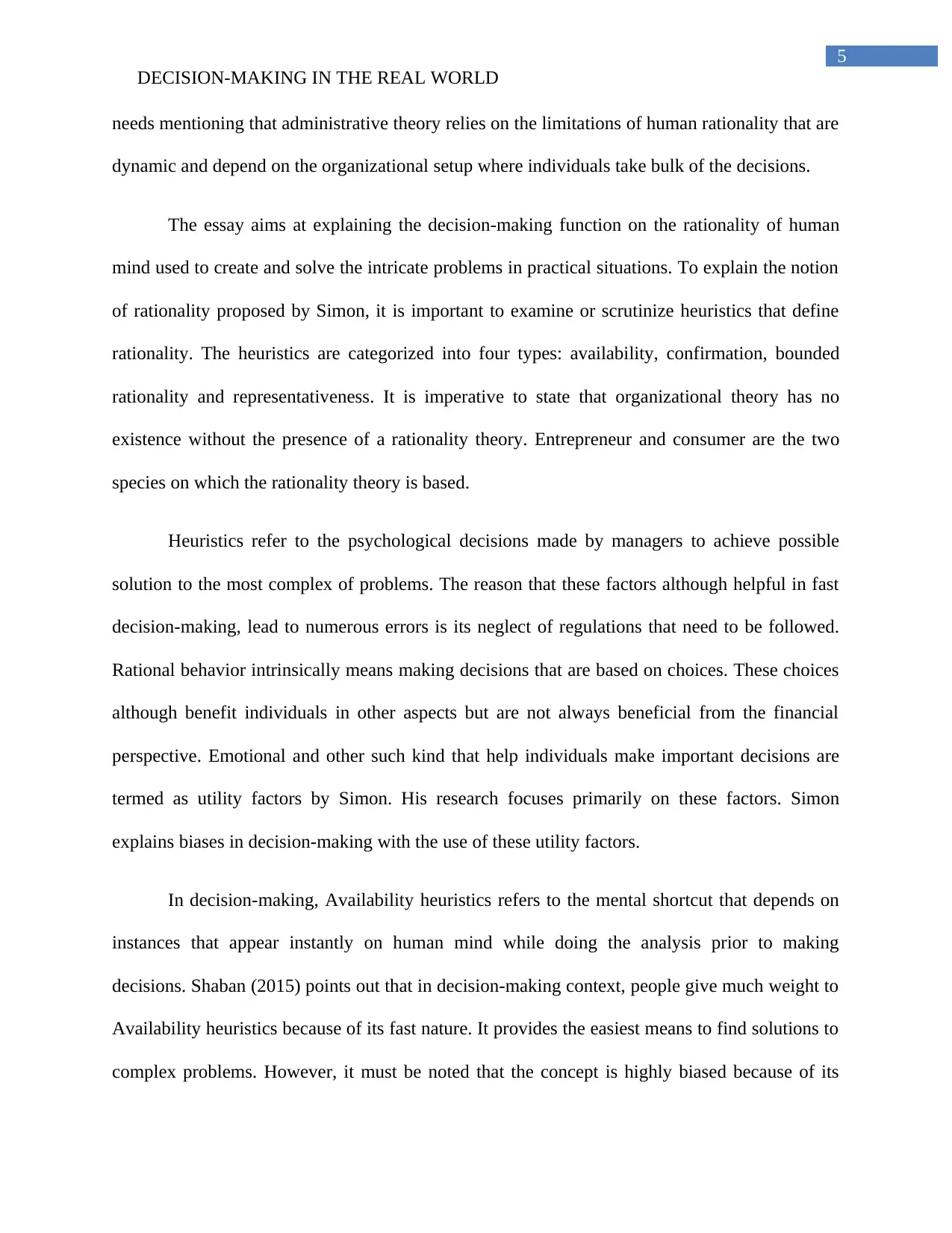
5
DECISION-MAKING IN THE REAL WORLD
needs mentioning that administrative theory relies on the limitations of human rationality that are
dynamic and depend on the organizational setup where individuals take bulk of the decisions.
The essay aims at explaining the decision-making function on the rationality of human
mind used to create and solve the intricate problems in practical situations. To explain the notion
of rationality proposed by Simon, it is important to examine or scrutinize heuristics that define
rationality. The heuristics are categorized into four types: availability, confirmation, bounded
rationality and representativeness. It is imperative to state that organizational theory has no
existence without the presence of a rationality theory. Entrepreneur and consumer are the two
species on which the rationality theory is based.
Heuristics refer to the psychological decisions made by managers to achieve possible
solution to the most complex of problems. The reason that these factors although helpful in fast
decision-making, lead to numerous errors is its neglect of regulations that need to be followed.
Rational behavior intrinsically means making decisions that are based on choices. These choices
although benefit individuals in other aspects but are not always beneficial from the financial
perspective. Emotional and other such kind that help individuals make important decisions are
termed as utility factors by Simon. His research focuses primarily on these factors. Simon
explains biases in decision-making with the use of these utility factors.
In decision-making, Availability heuristics refers to the mental shortcut that depends on
instances that appear instantly on human mind while doing the analysis prior to making
decisions. Shaban (2015) points out that in decision-making context, people give much weight to
Availability heuristics because of its fast nature. It provides the easiest means to find solutions to
complex problems. However, it must be noted that the concept is highly biased because of its
DECISION-MAKING IN THE REAL WORLD
needs mentioning that administrative theory relies on the limitations of human rationality that are
dynamic and depend on the organizational setup where individuals take bulk of the decisions.
The essay aims at explaining the decision-making function on the rationality of human
mind used to create and solve the intricate problems in practical situations. To explain the notion
of rationality proposed by Simon, it is important to examine or scrutinize heuristics that define
rationality. The heuristics are categorized into four types: availability, confirmation, bounded
rationality and representativeness. It is imperative to state that organizational theory has no
existence without the presence of a rationality theory. Entrepreneur and consumer are the two
species on which the rationality theory is based.
Heuristics refer to the psychological decisions made by managers to achieve possible
solution to the most complex of problems. The reason that these factors although helpful in fast
decision-making, lead to numerous errors is its neglect of regulations that need to be followed.
Rational behavior intrinsically means making decisions that are based on choices. These choices
although benefit individuals in other aspects but are not always beneficial from the financial
perspective. Emotional and other such kind that help individuals make important decisions are
termed as utility factors by Simon. His research focuses primarily on these factors. Simon
explains biases in decision-making with the use of these utility factors.
In decision-making, Availability heuristics refers to the mental shortcut that depends on
instances that appear instantly on human mind while doing the analysis prior to making
decisions. Shaban (2015) points out that in decision-making context, people give much weight to
Availability heuristics because of its fast nature. It provides the easiest means to find solutions to
complex problems. However, it must be noted that the concept is highly biased because of its
⊘ This is a preview!⊘
Do you want full access?
Subscribe today to unlock all pages.

Trusted by 1+ million students worldwide
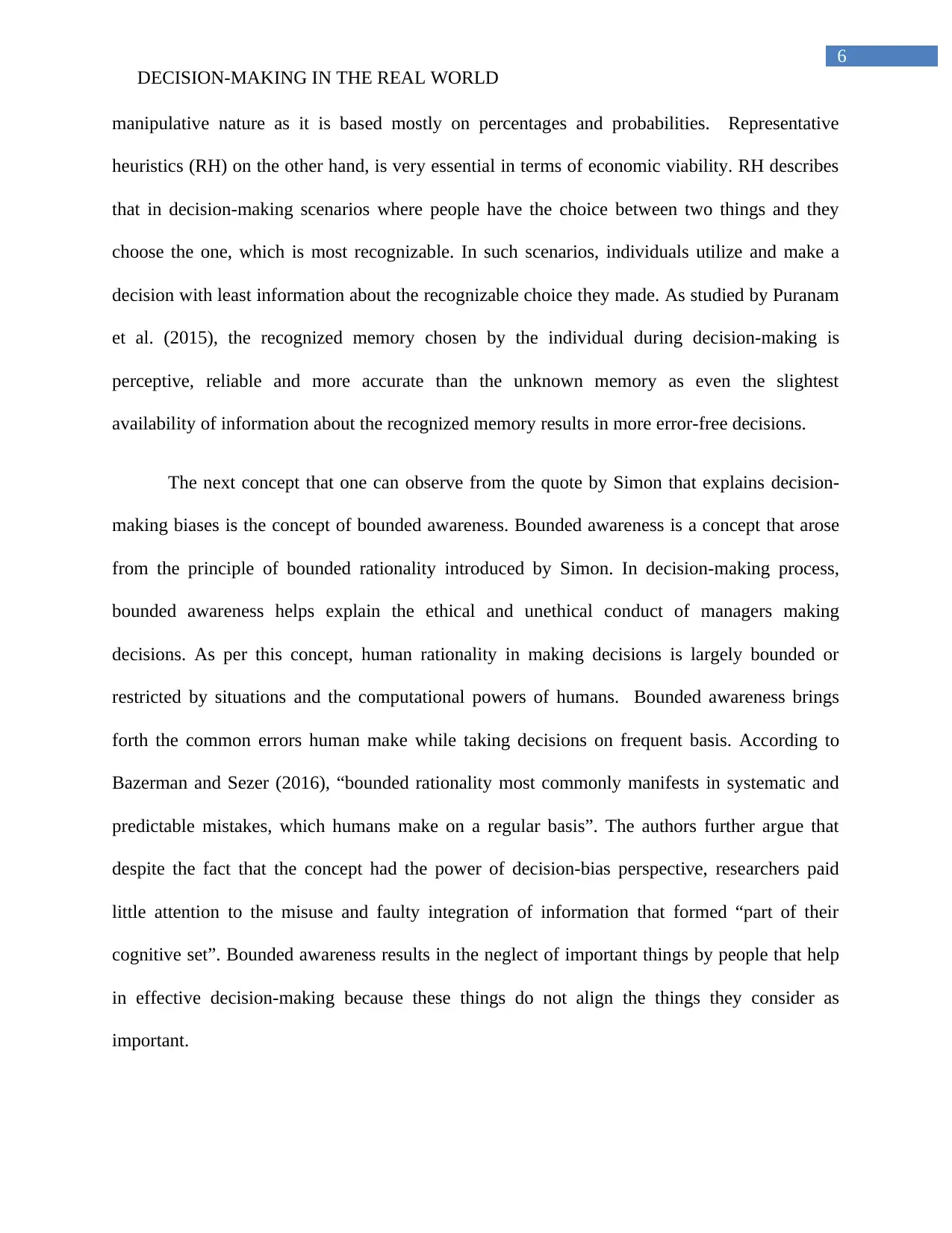
6
DECISION-MAKING IN THE REAL WORLD
manipulative nature as it is based mostly on percentages and probabilities. Representative
heuristics (RH) on the other hand, is very essential in terms of economic viability. RH describes
that in decision-making scenarios where people have the choice between two things and they
choose the one, which is most recognizable. In such scenarios, individuals utilize and make a
decision with least information about the recognizable choice they made. As studied by Puranam
et al. (2015), the recognized memory chosen by the individual during decision-making is
perceptive, reliable and more accurate than the unknown memory as even the slightest
availability of information about the recognized memory results in more error-free decisions.
The next concept that one can observe from the quote by Simon that explains decision-
making biases is the concept of bounded awareness. Bounded awareness is a concept that arose
from the principle of bounded rationality introduced by Simon. In decision-making process,
bounded awareness helps explain the ethical and unethical conduct of managers making
decisions. As per this concept, human rationality in making decisions is largely bounded or
restricted by situations and the computational powers of humans. Bounded awareness brings
forth the common errors human make while taking decisions on frequent basis. According to
Bazerman and Sezer (2016), “bounded rationality most commonly manifests in systematic and
predictable mistakes, which humans make on a regular basis”. The authors further argue that
despite the fact that the concept had the power of decision-bias perspective, researchers paid
little attention to the misuse and faulty integration of information that formed “part of their
cognitive set”. Bounded awareness results in the neglect of important things by people that help
in effective decision-making because these things do not align the things they consider as
important.
DECISION-MAKING IN THE REAL WORLD
manipulative nature as it is based mostly on percentages and probabilities. Representative
heuristics (RH) on the other hand, is very essential in terms of economic viability. RH describes
that in decision-making scenarios where people have the choice between two things and they
choose the one, which is most recognizable. In such scenarios, individuals utilize and make a
decision with least information about the recognizable choice they made. As studied by Puranam
et al. (2015), the recognized memory chosen by the individual during decision-making is
perceptive, reliable and more accurate than the unknown memory as even the slightest
availability of information about the recognized memory results in more error-free decisions.
The next concept that one can observe from the quote by Simon that explains decision-
making biases is the concept of bounded awareness. Bounded awareness is a concept that arose
from the principle of bounded rationality introduced by Simon. In decision-making process,
bounded awareness helps explain the ethical and unethical conduct of managers making
decisions. As per this concept, human rationality in making decisions is largely bounded or
restricted by situations and the computational powers of humans. Bounded awareness brings
forth the common errors human make while taking decisions on frequent basis. According to
Bazerman and Sezer (2016), “bounded rationality most commonly manifests in systematic and
predictable mistakes, which humans make on a regular basis”. The authors further argue that
despite the fact that the concept had the power of decision-bias perspective, researchers paid
little attention to the misuse and faulty integration of information that formed “part of their
cognitive set”. Bounded awareness results in the neglect of important things by people that help
in effective decision-making because these things do not align the things they consider as
important.
Paraphrase This Document
Need a fresh take? Get an instant paraphrase of this document with our AI Paraphraser
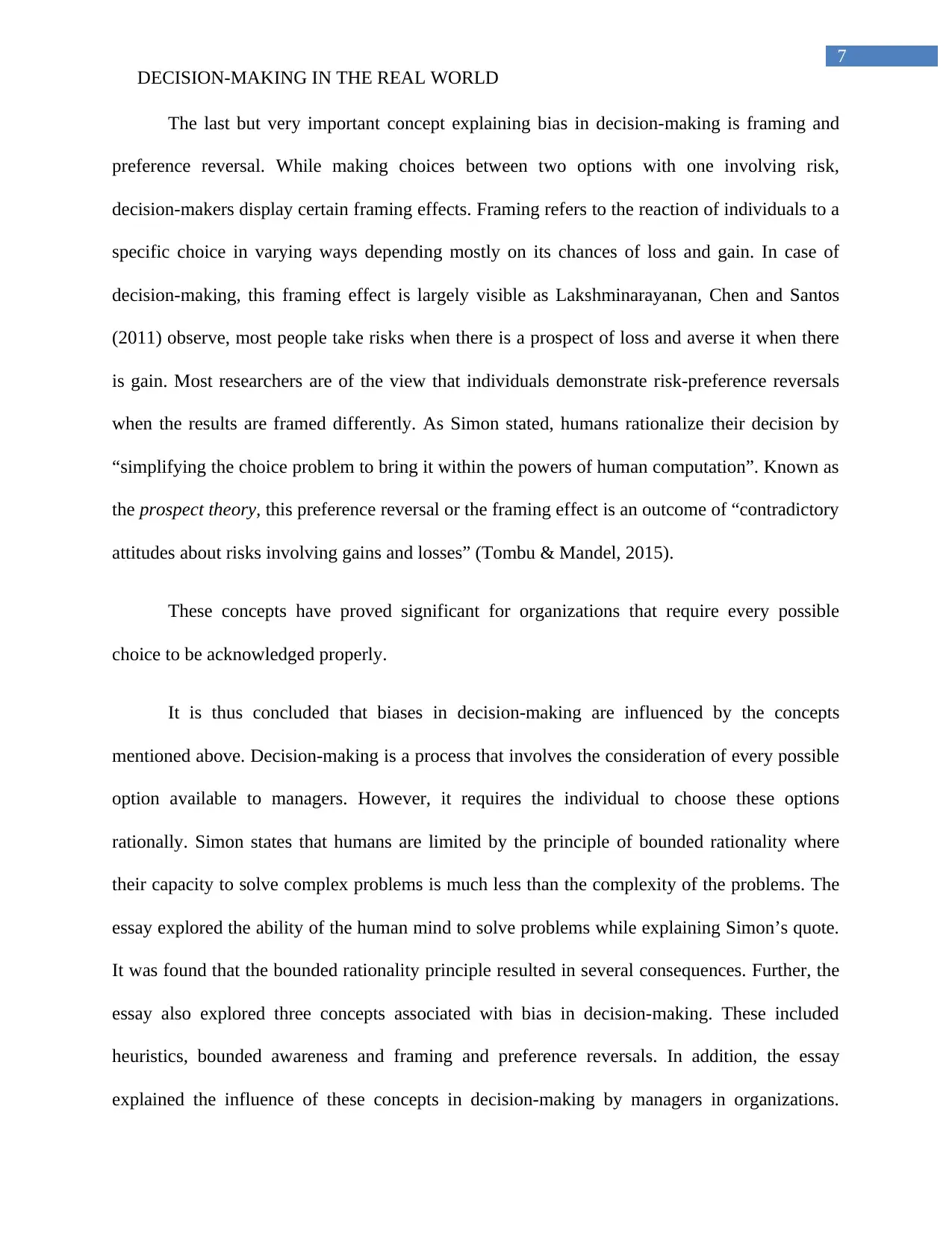
7
DECISION-MAKING IN THE REAL WORLD
The last but very important concept explaining bias in decision-making is framing and
preference reversal. While making choices between two options with one involving risk,
decision-makers display certain framing effects. Framing refers to the reaction of individuals to a
specific choice in varying ways depending mostly on its chances of loss and gain. In case of
decision-making, this framing effect is largely visible as Lakshminarayanan, Chen and Santos
(2011) observe, most people take risks when there is a prospect of loss and averse it when there
is gain. Most researchers are of the view that individuals demonstrate risk-preference reversals
when the results are framed differently. As Simon stated, humans rationalize their decision by
“simplifying the choice problem to bring it within the powers of human computation”. Known as
the prospect theory, this preference reversal or the framing effect is an outcome of “contradictory
attitudes about risks involving gains and losses” (Tombu & Mandel, 2015).
These concepts have proved significant for organizations that require every possible
choice to be acknowledged properly.
It is thus concluded that biases in decision-making are influenced by the concepts
mentioned above. Decision-making is a process that involves the consideration of every possible
option available to managers. However, it requires the individual to choose these options
rationally. Simon states that humans are limited by the principle of bounded rationality where
their capacity to solve complex problems is much less than the complexity of the problems. The
essay explored the ability of the human mind to solve problems while explaining Simon’s quote.
It was found that the bounded rationality principle resulted in several consequences. Further, the
essay also explored three concepts associated with bias in decision-making. These included
heuristics, bounded awareness and framing and preference reversals. In addition, the essay
explained the influence of these concepts in decision-making by managers in organizations.
DECISION-MAKING IN THE REAL WORLD
The last but very important concept explaining bias in decision-making is framing and
preference reversal. While making choices between two options with one involving risk,
decision-makers display certain framing effects. Framing refers to the reaction of individuals to a
specific choice in varying ways depending mostly on its chances of loss and gain. In case of
decision-making, this framing effect is largely visible as Lakshminarayanan, Chen and Santos
(2011) observe, most people take risks when there is a prospect of loss and averse it when there
is gain. Most researchers are of the view that individuals demonstrate risk-preference reversals
when the results are framed differently. As Simon stated, humans rationalize their decision by
“simplifying the choice problem to bring it within the powers of human computation”. Known as
the prospect theory, this preference reversal or the framing effect is an outcome of “contradictory
attitudes about risks involving gains and losses” (Tombu & Mandel, 2015).
These concepts have proved significant for organizations that require every possible
choice to be acknowledged properly.
It is thus concluded that biases in decision-making are influenced by the concepts
mentioned above. Decision-making is a process that involves the consideration of every possible
option available to managers. However, it requires the individual to choose these options
rationally. Simon states that humans are limited by the principle of bounded rationality where
their capacity to solve complex problems is much less than the complexity of the problems. The
essay explored the ability of the human mind to solve problems while explaining Simon’s quote.
It was found that the bounded rationality principle resulted in several consequences. Further, the
essay also explored three concepts associated with bias in decision-making. These included
heuristics, bounded awareness and framing and preference reversals. In addition, the essay
explained the influence of these concepts in decision-making by managers in organizations.
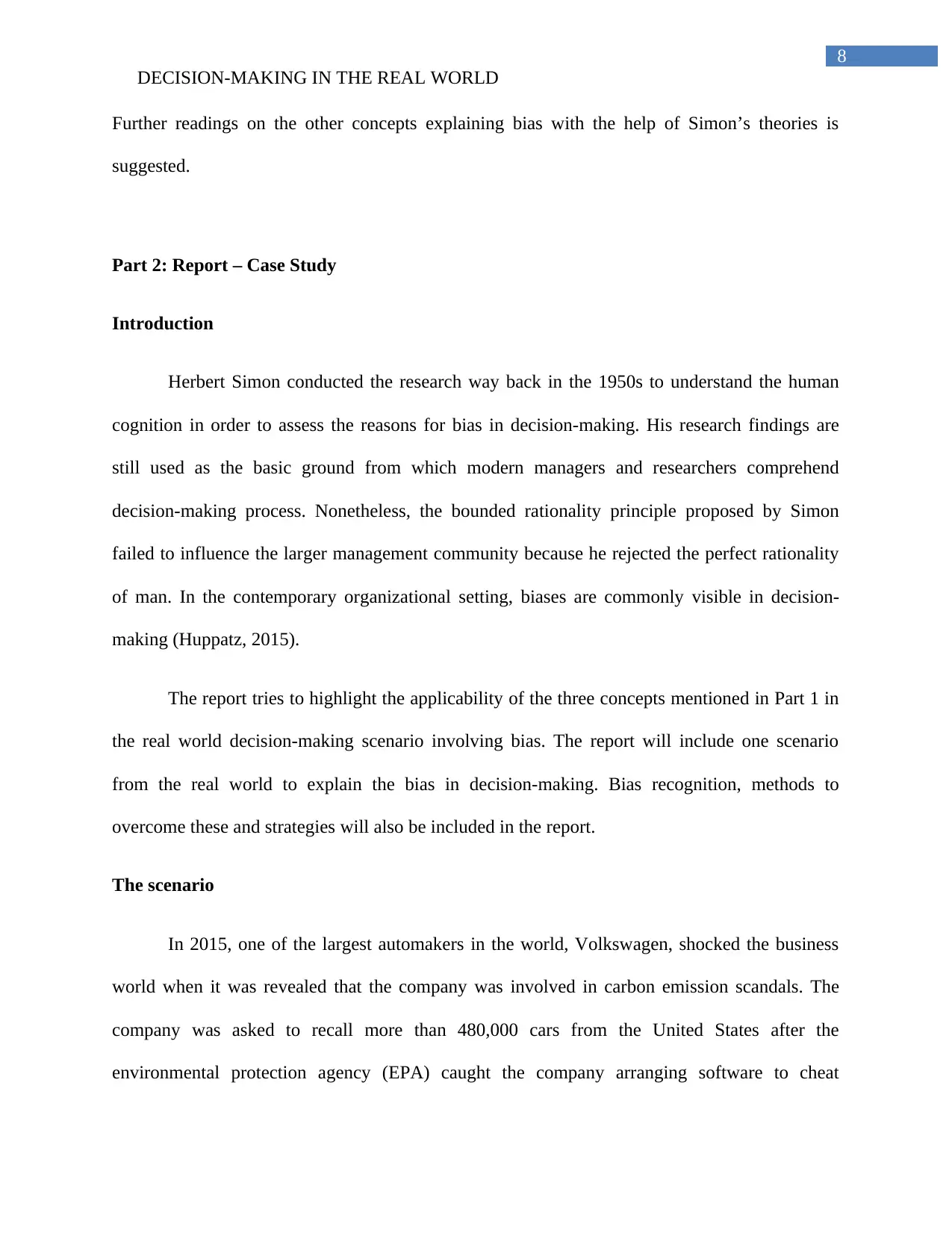
8
DECISION-MAKING IN THE REAL WORLD
Further readings on the other concepts explaining bias with the help of Simon’s theories is
suggested.
Part 2: Report – Case Study
Introduction
Herbert Simon conducted the research way back in the 1950s to understand the human
cognition in order to assess the reasons for bias in decision-making. His research findings are
still used as the basic ground from which modern managers and researchers comprehend
decision-making process. Nonetheless, the bounded rationality principle proposed by Simon
failed to influence the larger management community because he rejected the perfect rationality
of man. In the contemporary organizational setting, biases are commonly visible in decision-
making (Huppatz, 2015).
The report tries to highlight the applicability of the three concepts mentioned in Part 1 in
the real world decision-making scenario involving bias. The report will include one scenario
from the real world to explain the bias in decision-making. Bias recognition, methods to
overcome these and strategies will also be included in the report.
The scenario
In 2015, one of the largest automakers in the world, Volkswagen, shocked the business
world when it was revealed that the company was involved in carbon emission scandals. The
company was asked to recall more than 480,000 cars from the United States after the
environmental protection agency (EPA) caught the company arranging software to cheat
DECISION-MAKING IN THE REAL WORLD
Further readings on the other concepts explaining bias with the help of Simon’s theories is
suggested.
Part 2: Report – Case Study
Introduction
Herbert Simon conducted the research way back in the 1950s to understand the human
cognition in order to assess the reasons for bias in decision-making. His research findings are
still used as the basic ground from which modern managers and researchers comprehend
decision-making process. Nonetheless, the bounded rationality principle proposed by Simon
failed to influence the larger management community because he rejected the perfect rationality
of man. In the contemporary organizational setting, biases are commonly visible in decision-
making (Huppatz, 2015).
The report tries to highlight the applicability of the three concepts mentioned in Part 1 in
the real world decision-making scenario involving bias. The report will include one scenario
from the real world to explain the bias in decision-making. Bias recognition, methods to
overcome these and strategies will also be included in the report.
The scenario
In 2015, one of the largest automakers in the world, Volkswagen, shocked the business
world when it was revealed that the company was involved in carbon emission scandals. The
company was asked to recall more than 480,000 cars from the United States after the
environmental protection agency (EPA) caught the company arranging software to cheat
⊘ This is a preview!⊘
Do you want full access?
Subscribe today to unlock all pages.

Trusted by 1+ million students worldwide
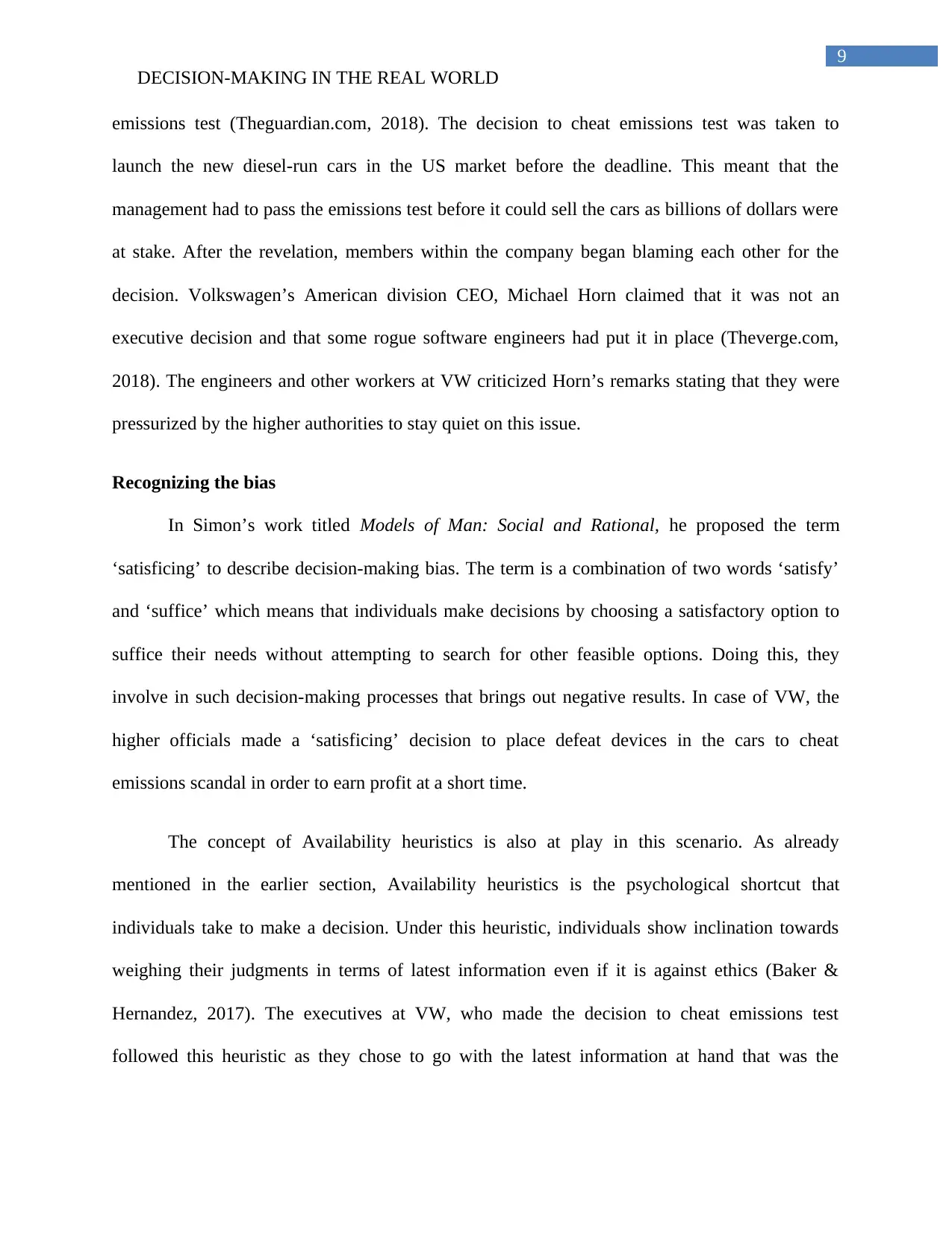
9
DECISION-MAKING IN THE REAL WORLD
emissions test (Theguardian.com, 2018). The decision to cheat emissions test was taken to
launch the new diesel-run cars in the US market before the deadline. This meant that the
management had to pass the emissions test before it could sell the cars as billions of dollars were
at stake. After the revelation, members within the company began blaming each other for the
decision. Volkswagen’s American division CEO, Michael Horn claimed that it was not an
executive decision and that some rogue software engineers had put it in place (Theverge.com,
2018). The engineers and other workers at VW criticized Horn’s remarks stating that they were
pressurized by the higher authorities to stay quiet on this issue.
Recognizing the bias
In Simon’s work titled Models of Man: Social and Rational, he proposed the term
‘satisficing’ to describe decision-making bias. The term is a combination of two words ‘satisfy’
and ‘suffice’ which means that individuals make decisions by choosing a satisfactory option to
suffice their needs without attempting to search for other feasible options. Doing this, they
involve in such decision-making processes that brings out negative results. In case of VW, the
higher officials made a ‘satisficing’ decision to place defeat devices in the cars to cheat
emissions scandal in order to earn profit at a short time.
The concept of Availability heuristics is also at play in this scenario. As already
mentioned in the earlier section, Availability heuristics is the psychological shortcut that
individuals take to make a decision. Under this heuristic, individuals show inclination towards
weighing their judgments in terms of latest information even if it is against ethics (Baker &
Hernandez, 2017). The executives at VW, who made the decision to cheat emissions test
followed this heuristic as they chose to go with the latest information at hand that was the
DECISION-MAKING IN THE REAL WORLD
emissions test (Theguardian.com, 2018). The decision to cheat emissions test was taken to
launch the new diesel-run cars in the US market before the deadline. This meant that the
management had to pass the emissions test before it could sell the cars as billions of dollars were
at stake. After the revelation, members within the company began blaming each other for the
decision. Volkswagen’s American division CEO, Michael Horn claimed that it was not an
executive decision and that some rogue software engineers had put it in place (Theverge.com,
2018). The engineers and other workers at VW criticized Horn’s remarks stating that they were
pressurized by the higher authorities to stay quiet on this issue.
Recognizing the bias
In Simon’s work titled Models of Man: Social and Rational, he proposed the term
‘satisficing’ to describe decision-making bias. The term is a combination of two words ‘satisfy’
and ‘suffice’ which means that individuals make decisions by choosing a satisfactory option to
suffice their needs without attempting to search for other feasible options. Doing this, they
involve in such decision-making processes that brings out negative results. In case of VW, the
higher officials made a ‘satisficing’ decision to place defeat devices in the cars to cheat
emissions scandal in order to earn profit at a short time.
The concept of Availability heuristics is also at play in this scenario. As already
mentioned in the earlier section, Availability heuristics is the psychological shortcut that
individuals take to make a decision. Under this heuristic, individuals show inclination towards
weighing their judgments in terms of latest information even if it is against ethics (Baker &
Hernandez, 2017). The executives at VW, who made the decision to cheat emissions test
followed this heuristic as they chose to go with the latest information at hand that was the
Paraphrase This Document
Need a fresh take? Get an instant paraphrase of this document with our AI Paraphraser
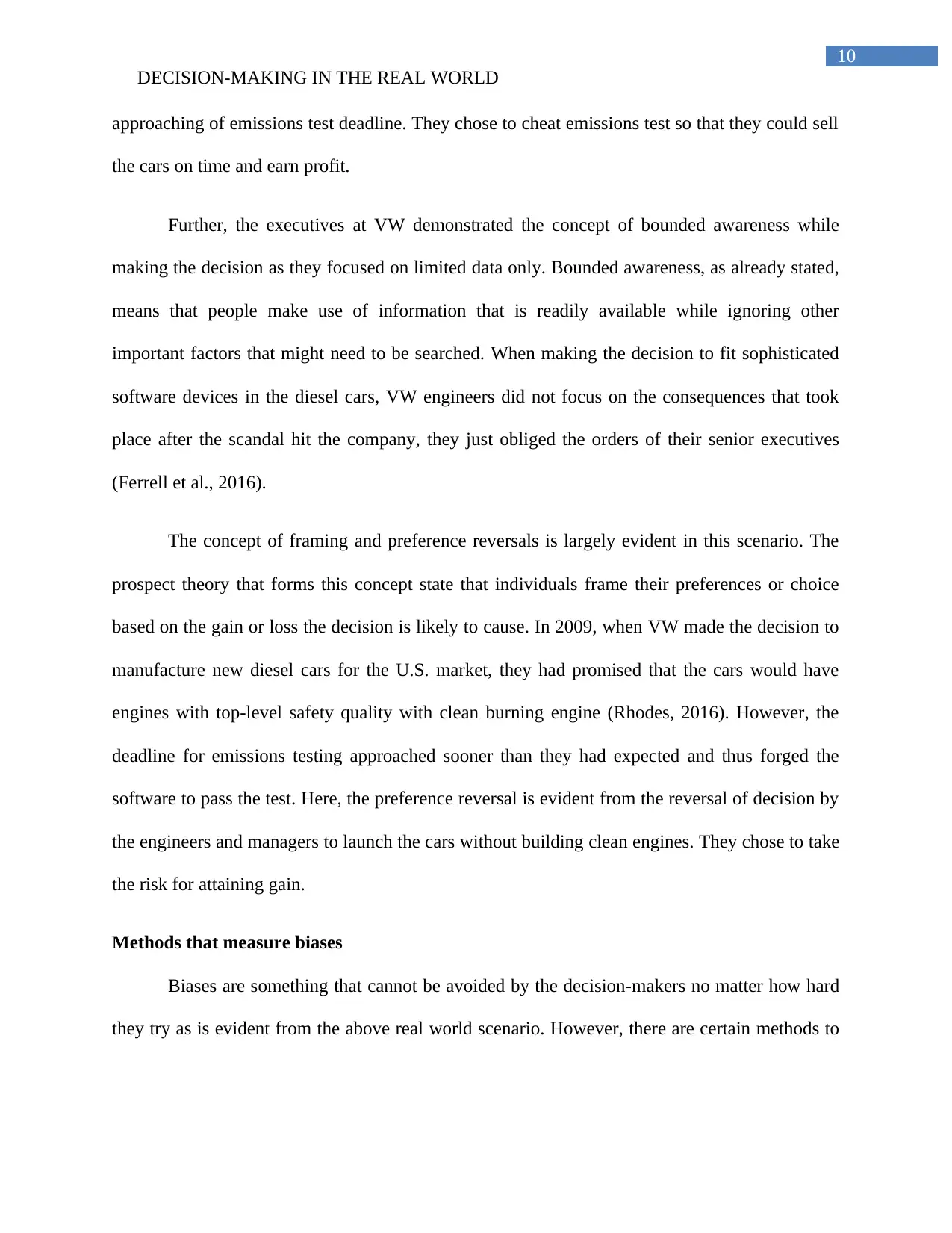
10
DECISION-MAKING IN THE REAL WORLD
approaching of emissions test deadline. They chose to cheat emissions test so that they could sell
the cars on time and earn profit.
Further, the executives at VW demonstrated the concept of bounded awareness while
making the decision as they focused on limited data only. Bounded awareness, as already stated,
means that people make use of information that is readily available while ignoring other
important factors that might need to be searched. When making the decision to fit sophisticated
software devices in the diesel cars, VW engineers did not focus on the consequences that took
place after the scandal hit the company, they just obliged the orders of their senior executives
(Ferrell et al., 2016).
The concept of framing and preference reversals is largely evident in this scenario. The
prospect theory that forms this concept state that individuals frame their preferences or choice
based on the gain or loss the decision is likely to cause. In 2009, when VW made the decision to
manufacture new diesel cars for the U.S. market, they had promised that the cars would have
engines with top-level safety quality with clean burning engine (Rhodes, 2016). However, the
deadline for emissions testing approached sooner than they had expected and thus forged the
software to pass the test. Here, the preference reversal is evident from the reversal of decision by
the engineers and managers to launch the cars without building clean engines. They chose to take
the risk for attaining gain.
Methods that measure biases
Biases are something that cannot be avoided by the decision-makers no matter how hard
they try as is evident from the above real world scenario. However, there are certain methods to
DECISION-MAKING IN THE REAL WORLD
approaching of emissions test deadline. They chose to cheat emissions test so that they could sell
the cars on time and earn profit.
Further, the executives at VW demonstrated the concept of bounded awareness while
making the decision as they focused on limited data only. Bounded awareness, as already stated,
means that people make use of information that is readily available while ignoring other
important factors that might need to be searched. When making the decision to fit sophisticated
software devices in the diesel cars, VW engineers did not focus on the consequences that took
place after the scandal hit the company, they just obliged the orders of their senior executives
(Ferrell et al., 2016).
The concept of framing and preference reversals is largely evident in this scenario. The
prospect theory that forms this concept state that individuals frame their preferences or choice
based on the gain or loss the decision is likely to cause. In 2009, when VW made the decision to
manufacture new diesel cars for the U.S. market, they had promised that the cars would have
engines with top-level safety quality with clean burning engine (Rhodes, 2016). However, the
deadline for emissions testing approached sooner than they had expected and thus forged the
software to pass the test. Here, the preference reversal is evident from the reversal of decision by
the engineers and managers to launch the cars without building clean engines. They chose to take
the risk for attaining gain.
Methods that measure biases
Biases are something that cannot be avoided by the decision-makers no matter how hard
they try as is evident from the above real world scenario. However, there are certain methods to
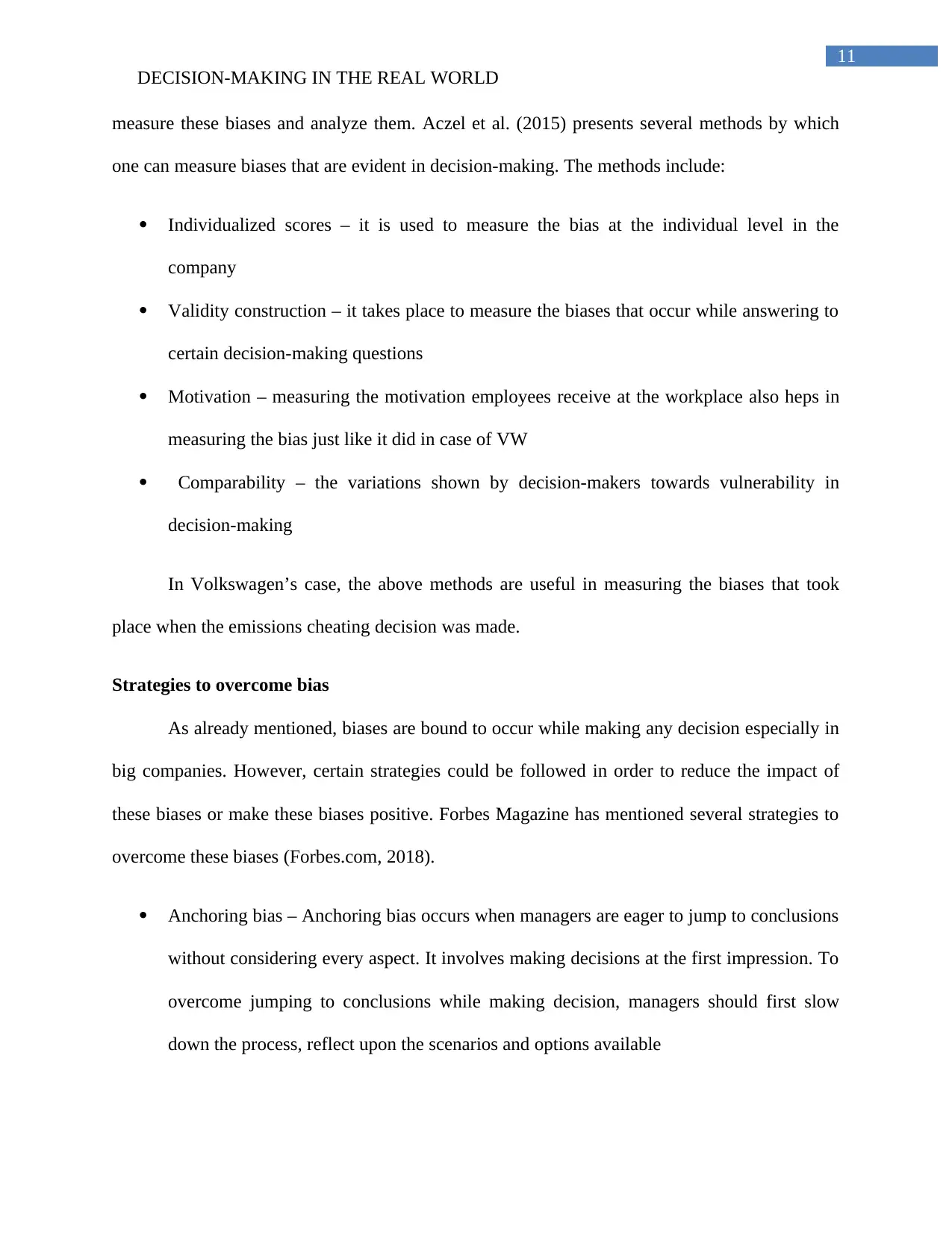
11
DECISION-MAKING IN THE REAL WORLD
measure these biases and analyze them. Aczel et al. (2015) presents several methods by which
one can measure biases that are evident in decision-making. The methods include:
Individualized scores – it is used to measure the bias at the individual level in the
company
Validity construction – it takes place to measure the biases that occur while answering to
certain decision-making questions
Motivation – measuring the motivation employees receive at the workplace also heps in
measuring the bias just like it did in case of VW
Comparability – the variations shown by decision-makers towards vulnerability in
decision-making
In Volkswagen’s case, the above methods are useful in measuring the biases that took
place when the emissions cheating decision was made.
Strategies to overcome bias
As already mentioned, biases are bound to occur while making any decision especially in
big companies. However, certain strategies could be followed in order to reduce the impact of
these biases or make these biases positive. Forbes Magazine has mentioned several strategies to
overcome these biases (Forbes.com, 2018).
Anchoring bias – Anchoring bias occurs when managers are eager to jump to conclusions
without considering every aspect. It involves making decisions at the first impression. To
overcome jumping to conclusions while making decision, managers should first slow
down the process, reflect upon the scenarios and options available
DECISION-MAKING IN THE REAL WORLD
measure these biases and analyze them. Aczel et al. (2015) presents several methods by which
one can measure biases that are evident in decision-making. The methods include:
Individualized scores – it is used to measure the bias at the individual level in the
company
Validity construction – it takes place to measure the biases that occur while answering to
certain decision-making questions
Motivation – measuring the motivation employees receive at the workplace also heps in
measuring the bias just like it did in case of VW
Comparability – the variations shown by decision-makers towards vulnerability in
decision-making
In Volkswagen’s case, the above methods are useful in measuring the biases that took
place when the emissions cheating decision was made.
Strategies to overcome bias
As already mentioned, biases are bound to occur while making any decision especially in
big companies. However, certain strategies could be followed in order to reduce the impact of
these biases or make these biases positive. Forbes Magazine has mentioned several strategies to
overcome these biases (Forbes.com, 2018).
Anchoring bias – Anchoring bias occurs when managers are eager to jump to conclusions
without considering every aspect. It involves making decisions at the first impression. To
overcome jumping to conclusions while making decision, managers should first slow
down the process, reflect upon the scenarios and options available
⊘ This is a preview!⊘
Do you want full access?
Subscribe today to unlock all pages.

Trusted by 1+ million students worldwide
1 out of 16
Related Documents
Your All-in-One AI-Powered Toolkit for Academic Success.
+13062052269
info@desklib.com
Available 24*7 on WhatsApp / Email
![[object Object]](/_next/static/media/star-bottom.7253800d.svg)
Unlock your academic potential
Copyright © 2020–2025 A2Z Services. All Rights Reserved. Developed and managed by ZUCOL.





